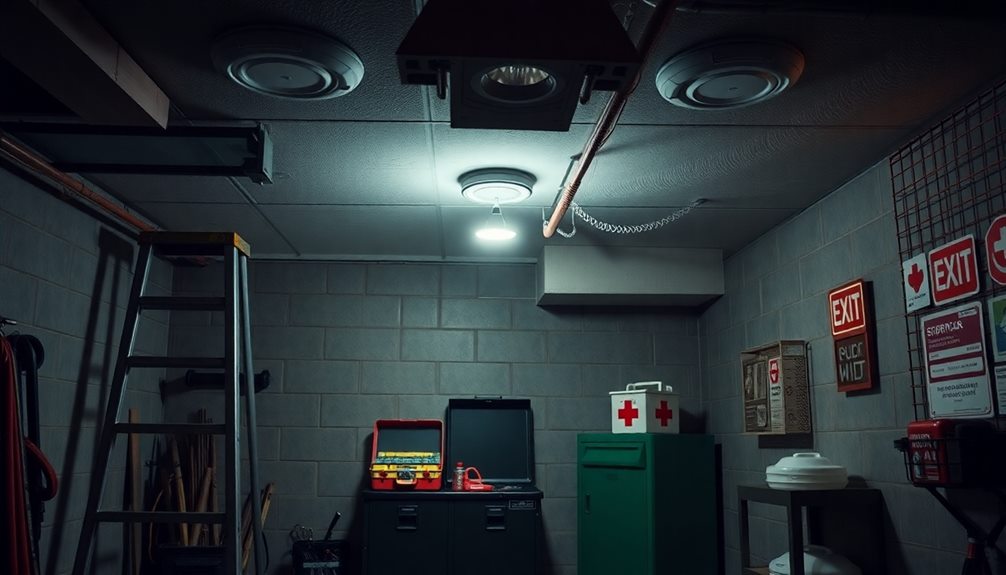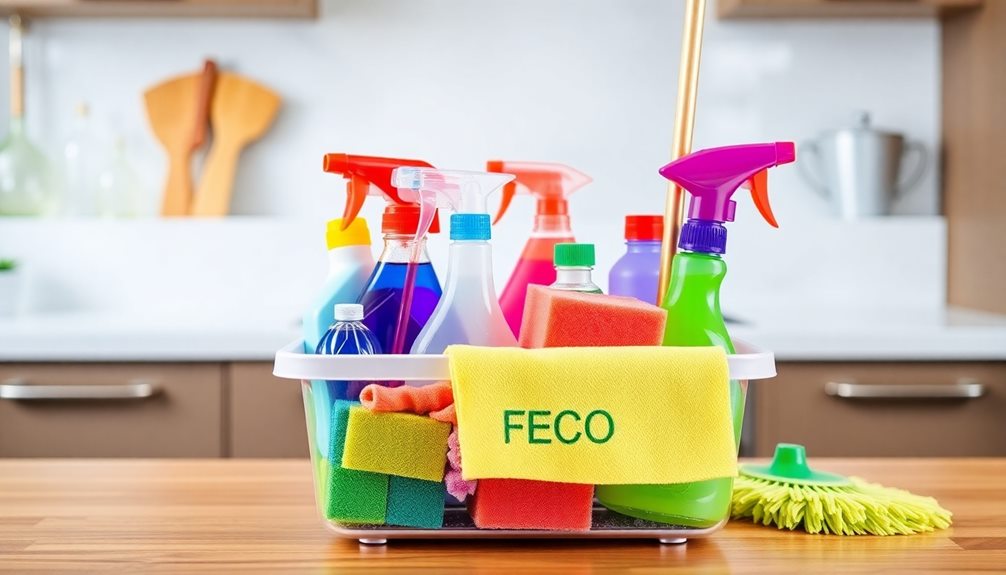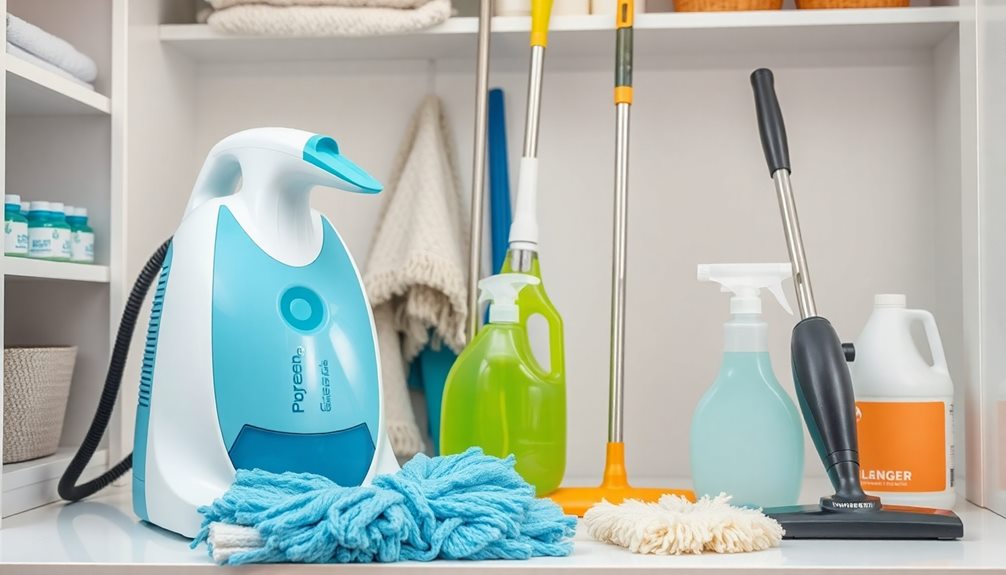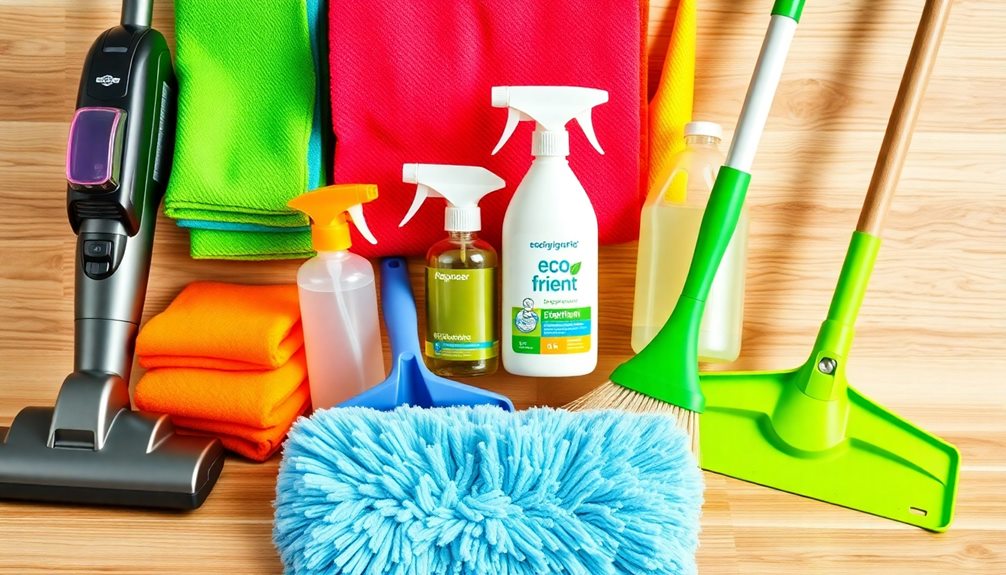Home Essentials
Home Safety Essentials: Room-by-Room Checklist
Stay informed with essential home safety tips tailored for every room, ensuring your loved ones are protected—discover the complete checklist inside!

To keep your home safe, start with a room-by-room checklist. In the kitchen, inspect appliances and install carbon monoxide detectors. For bathrooms, look for leaks and add non-slip mats. Check your basement's breaker and maintain your HVAC system. In hallways, secure rugs and guarantee good lighting. Living spaces should be free of tripping hazards, and outdoor areas need gate checks and tree pruning. Don't forget to plan for emergencies and enhance security with deadbolts and motion sensors. Follow these guidelines, and you'll find even more ways to protect your home and loved ones.
Key Takeaways
- Install smoke detectors on every floor and test them monthly to ensure functionality and safety.
- Maintain a well-stocked emergency kit with essential supplies for at least three days.
- Regularly inspect kitchen appliances and electrical circuits to prevent hazards.
- Secure rugs and paths to minimize tripping hazards in hallways and living spaces.
- Implement home security measures like deadbolts and motion detection sensors for enhanced safety.
Kitchen Safety Checklist
The kitchen is often the heart of the home, but it can also be a hotspot for safety hazards if not properly maintained. To guarantee your kitchen remains safe, regularly inspect your kitchen appliances for any signs of damage or improper installation. Faulty appliances can lead to serious fire hazards, so it's vital to address issues promptly.
Additionally, be mindful of any food items that could pose risks to pets, such as the dangers of raisins for dogs, which can inadvertently be left within reach.
Next, verify your range hood and exhaust fan are vented and cleaned regularly to prevent grease buildup, which increases fire risk. Install smoke detectors and carbon monoxide detectors in the kitchen and on every floor, testing them monthly to confirm they're functioning. These devices are essential components of your home safety system.
Don't forget about your water quality; check and replace water filters at least every six months to ensure access to clean drinking water.
Also, avoid overloading electrical circuits—consult an electrician to set up dedicated circuits for high-wattage appliances, keeping electrical fires at bay.
Bathroom Safety Checklist

Guaranteeing bathroom safety is vital for maintaining a healthy home environment. Start your bathroom safety checklist by inspecting pipes for signs of rust, corrosion, or leaks. These issues can lead to water damage and health hazards.
Every six months, test your faucets and toilets to verify they operate correctly and check for leaks to conserve water. Additionally, consider using an air purifier to enhance air quality and reduce allergens that may accumulate in bathroom spaces.
Next, clean showerheads regularly to maintain ideal water pressure and eliminate bacteria buildup. It's fundamental for your hygiene.
Pay attention to the caulking around the shower, tub, and sinks; any discoloration or cracks can be a sign of mold that needs immediate attention.
To prevent slips and falls, consider installing non-slip bath mats and grab bars. These additions provide stability and safety, especially for children or elderly family members.
Finally, familiarize yourself with the location and functionality of the main shut-off valve. In case of an emergency plumbing issue, this knowledge can minimize damage and protect your home.
Basement Safety Checklist

When it comes to home safety, basement areas often get overlooked, yet they play a significant role in your overall well-being. To guarantee your basement is safe and efficient, follow this checklist.
| Task | Frequency |
|---|---|
| Inspect main breaker | Monthly |
| Flush water heater | Annually |
| Clean air ducts | Every six months |
| Change HVAC air filters | Every three months |
Familiarize yourself with your home safety system by labeling the main breaker controls for quick access during emergencies. Regular inspections of your HVAC system will promote efficiency and prevent unexpected failures in heating and cooling.
Don't forget about your water heater—flushing it annually will help remove sediment buildup, reducing the risk of leaks. Additionally, cleaning air ducts and vents regularly minimizes allergens and fire hazards, improving air quality throughout your home.
Lastly, consider reviewing your home insurance policy to guarantee you're covered for any potential basement-related incidents. By taking these steps, you'll maintain a safe and healthy environment in one of your home's most common household areas.
Hallway Safety Checklist

Your hallway's safety is vital for preventing accidents and guaranteeing a smooth flow through your home. Start by following this hallway safety checklist.
Regularly check for loose rugs that could cause trips. Secure them with non-skid tape or mats to minimize hazards. Incorporating elements of modern farmhouse decor can't only enhance the aesthetic appeal but also promote a safer environment with functional designs.
Installing night lights with motion sensors is a great way to enhance visibility during nighttime, helping you navigate safely.
Next, keep your pathways clear. Trim any overgrown plants or trees that might obstruct light or movement. This guarantees you won't trip over anything unexpected.
Periodic inspections for loose floorboards or carpet edges are vital, as they greatly reduce the risk of slips and falls.
Don't forget about electrical hazards. Regularly inspect your hallway outlets and replace any missing or damaged outlet covers. This simple step protects against potential shocks and accidents.
Living Spaces Safety Checklist

A safe living space is essential for preventing accidents and guaranteeing comfort in your home. Start by removing tripping hazards; secure loose rugs and keep pathways clear. This will help you avoid falls and injuries.
Install nightlights with motion sensors in hallways and living areas for better visibility at night—this simple step can considerably reduce accident risks.
Next, conduct regular inspections of your furniture. Make sure items like bookshelves and cabinets are anchored to the wall to prevent tipping.
Keep electrical cords organized and away from high-traffic areas to minimize tripping hazards and reduce the risk of common fire incidents.
Incorporate first aid kits into your home safety system. Having a stocked first aid kit readily available gives you peace of mind and guarantees you're prepared for minor injuries.
Outdoor Safety Checklist

Outdoor safety is essential for protecting your property and loved ones. Start by regularly inspecting your roof for cracked or missing shingles; this can prevent water leaks and costly structural damage.
Don't forget to clean your rain gutters and downspouts frequently, as clogged gutters can lead to water damage and mold growth.
Next, check all gates to confirm they're functional and secure with working latches. This added security can deter unauthorized access and keep your family safe.
Prune trees and shrubs around your property to eliminate hiding spots for potential intruders, maintaining clear visibility.
Store dangerous household items like fertilizers and chemicals in locked cabinets or high places, making them out of reach of children and pets.
Additionally, make certain your window and door locks are in good working condition to enhance your home security system.
Regularly review this outdoor safety checklist to keep your environment secure and safe for everyone.
Emergency Preparedness Steps

While securing your outdoor space is essential, being prepared for emergencies inside your home is equally important. Start by installing smoke detectors on every floor and in sleeping areas. Test them monthly and replace the batteries annually to keep your home safe.
Next, create an emergency contact list that includes family members, local emergency services, and poison control. Post this list in a visible spot, like your fridge, so everyone knows where to find it.
Assemble a thorough emergency kit containing at least three days' worth of non-perishable food and water, a flashlight, batteries, and a first aid kit. This guarantees you're ready for any unexpected situation.
Additionally, develop and practice an escape plan that outlines multiple exits from your home and a designated meeting spot outside. Make sure all family members are familiar with it.
Lastly, stay informed about potential natural disasters by regularly reviewing local weather forecasts and alerts. This allows you to prepare and evacuate if necessary, keeping your family safe during emergencies.
Home Security Measures

Securing your home is essential for protecting your loved ones and belongings from potential threats. Implementing effective home security measures can greatly reduce the risk of break-ins. Did you know that homes without security systems are 300% more likely to be broken into?
Start with installing deadbolts on all exterior doors. These provide better resistance against forced entry. Consider adding motion detection sensors to alert you of intruders, allowing for quicker responses. Video doorbell cameras not only monitor visitors but also deter criminal activity through visible surveillance.
To guarantee you're on top of your home security, regularly update and test your security systems, including alarms and cameras, to maintain peak protection.
Here's a quick reference table to help you remember key security features:
| Security Measure | Purpose |
|---|---|
| Deadbolts | Enhance resistance against forced entry |
| Motion Detection Sensors | Alert homeowners of potential intruders |
| Video Doorbell Cameras | Monitor visitors and deter crime |
| Security Systems | Provide thorough protection |
Frequently Asked Questions
What Are Common Household Hazards to Look For?
Common household hazards include slippery floors, exposed wires, cluttered walkways, and chemicals stored improperly. You should check for smoke detectors, carbon monoxide alarms, and verify your fire extinguishers are accessible and functional to enhance safety.
How Often Should I Update My Safety Checklist?
You might feel secure now, but don't let complacency creep in. Update your safety checklist at least twice a year or whenever significant changes occur in your home. Stay proactive to guarantee ongoing safety.
Are There Safety Devices I Can Install Myself?
Yes, you can install several safety devices yourself. Consider smoke detectors, carbon monoxide alarms, and security cameras. Just follow the manufacturer's instructions, guarantee proper placement, and test each device to confirm they're functioning correctly.
How Can I Teach Children About Home Safety?
You might wonder how to instill a sense of safety in your children. Start with engaging discussions, role-playing scenarios, and fun activities that highlight hazards. This way, you'll empower them to recognize and avoid dangers effectively.
What Should I Do if I Find a Safety Issue?
If you find a safety issue, address it immediately. Assess the severity, and if it's serious, call a professional. Fix minor problems yourself, but always prioritize your safety and guarantee it won't happen again.
Conclusion
By taking the time to go through this room-by-room safety checklist, you're investing in your family's well-being. You might think it's overwhelming, but breaking it down into manageable tasks makes it easier. After all, a safe home doesn't just protect your possessions; it safeguards your loved ones. So, roll up your sleeves and tackle one area at a time. You'll feel more secure and confident in your space, knowing you've done everything you can to keep them safe.
Xavier – Your Operations Partner Xavier is your operations partner, working tirelessly behind the scenes to ensure that everything runs smoothly so you can enjoy a seamless experience with Perfect Fit Living. From managing inventory to coordinating logistics, he’s committed to making your experience with us hassle-free.
Home Essentials
Essential Garden Tools for Every Home Gardener
Discover the must-have tools every home gardener needs to flourish, and learn how they can transform your gardening experience into something extraordinary.

Every home gardener needs essential tools to cultivate a thriving garden. Start with hand pruners and loppers for precise cutting and shaping. A sturdy spade and trowel are crucial for digging and planting, while a garden fork aerates and mixes your soil. Don't forget watering cans or a hose for effective irrigation. For transport, a reliable wheelbarrow or garden cart makes moving soil or plants effortless. Investing in these tools will enhance your gardening experience, helping you work smarter, not harder. If you're curious about more specifics on each tool, the details might surprise you!
Key Takeaways
- A reliable spade is crucial for digging and edging, featuring ergonomic designs to reduce back strain.
- Bypass hand pruners provide clean cuts for healthy plants, making them essential for pruning tasks.
- Gardening knives are versatile tools perfect for planting bulbs and weeding efficiently.
- A garden rake with flexible tines helps level soil and collect debris without damaging delicate plants.
- Watering cans and hoses are vital for effective watering, ensuring plants receive the moisture they need.
Essential Hand Tools
When it comes to gardening, having the right hand tools can make all the difference in your efficiency and enjoyment. Essential tools like a sturdy gardening knife allow you to tackle a variety of tasks, from planting bulbs to weeding.
A good pair of hand pruners is vital for pruning trees and trimming plants, with bypass models providing a clean cut that promotes healthy growth.
When you're digging holes, you'll want a reliable spade, especially one with ergonomic designs that reduce back strain.
Consider using a garden rake with steel blades to level soil and collect debris, while flexible tines can help you navigate delicate areas without damaging your plants.
Investing in quality hand tools not only enhances your gardening experience but also guarantees you can work longer without fatigue. Each tool serves a specific purpose, making your time in the garden more productive.
Cutting and Pruning Tools

Having the right tools for cutting and pruning can elevate your gardening game considerably. Pruning shears are essential for trimming live plants, available in bypass and anvil types, with sharp blades that guarantee clean cuts and minimize stress on your plants.
For reaching high branches, loppers are a fantastic choice; their long handles can cut through wood up to 1 inch in diameter while lightweight materials keep you from getting fatigued.
When you encounter larger branches, a quality pruning saw, typically with a 9 to 13 inch blade, is your go-to tool. Its cutting action occurs on the pull stroke, providing precision for those tough jobs.
Don't forget about hand pruners, which come in various sizes and designs. Picking the right fit based on your hand size and cutting capacity enhances your comfort and efficiency during use.
To keep your cutting tools in top shape, remember that regular sharpening is vital. Sharp blades not only prolong the lifespan of your tools but also guarantee cleaner cuts, promoting healthier plants overall.
Investing in these cutting and pruning tools will make all the difference in your garden's success.
Digging and Planting Equipment

Digging and planting equipment is essential for any gardener aiming to create a thriving garden. With the right tools, you'll find digging and planting becomes more efficient and enjoyable.
Here are the top tools you need:
- Garden Fork: This tool's curved spines aerate soil and mix compost effectively. It's perfect for scooping mulch and tackling rocky or compacted soil with its straight tines.
- Trowel: A hand trowel, typically 14 inches long, is versatile for digging, transplanting, and weeding. Its broad blades move soil while the narrow ones handle precision tasks with ease.
- Spade: Featuring a flat blade, a spade is ideal for making precise cuts, edging, and moving soil. Available in various sizes, ergonomic designs help reduce strain on your handle.
- Seed Dibber: This handy tool creates holes for seed placement, ensuring the best spacing and depth for successful germination.
- Transplanting Spade: Specifically designed for moving seedlings without damage, this tool allows for careful handling and placement in your garden.
With these essential gardening tools, you'll be well-equipped to dig and plant with confidence!
Watering and Irrigation Supplies

In a flourishing garden, effective watering is just as essential as planting. To achieve efficient watering, you'll want to equip yourself with the right tools. Watering cans are perfect for targeted watering in small areas, while garden hoses come in various lengths and diameters, allowing you to adjust water pressure with adjustable nozzles.
Drip irrigation systems are a game-changer, delivering water directly to plant roots, minimizing evaporation, and helping you conserve water. Don't forget to measure rainfall with rainfall gauges, which help you establish the best watering schedules based on local precipitation levels.
Here's a quick overview of your watering supplies:
| Tool | Purpose |
|---|---|
| Watering Cans | Targeted watering in small areas |
| Garden Hoses | Flexible watering; control water pressure |
| Drip Irrigation | Efficient watering at the root level |
| Rainfall Gauges | Measure precipitation for scheduling |
| Watering Wands | Reach difficult areas with ease |
Lastly, proper storage of hoses is vital to prolong their lifespan. This prevents damage and tangling, ensuring you can easily access them whenever needed.
Garden Transport Solutions

When it comes to moving heavy loads around your garden, choosing the right transport solution can save you time and effort. Investing in the right tools, like a wheelbarrow or garden cart, makes a significant difference.
For example, using a best lawn fertilizers can enhance your garden's growth, making it even more vital to transport supplies efficiently. Here are four key options to take into account:
- Wheelbarrows: Essential for transporting heavy loads like soil and tools, they typically have weight capacities ranging from 300 to 600 pounds, ensuring you can handle most gardening tasks with ease.
- Garden Carts: Ideal for moving harvested vegetables and debris, these come in lightweight models for small tasks and larger carts for heavier materials, making them versatile for various needs.
- Wheel Configuration: Reflect on the wheel setup; single-wheel options are more maneuverable, while double-wheel designs provide increased stability for transporting heavier loads.
- Durable Materials: Opt for tools made from steel or plastic for longevity and resistance to wear and tear. Proper storage, like keeping them in a dry area and off the ground, can further enhance their lifespan.
Frequently Asked Questions
What Does Every Indoor Gardener Need?
Every indoor gardener needs a hand trowel for planting, a watering can for precise moisture, pruning shears for healthy growth, a soil moisture meter to avoid overwatering, and gardening gloves to protect your hands.
What Does Every Vegetable Gardener Need?
You might think gardening's simple, but without the right tools, it's tough. A hand trowel, pruning shears, garden fork, watering can, and wheelbarrow are essential for thriving vegetable gardens, ensuring you cultivate successfully.
What Are the 9 Gardening Tools?
When you start gardening, you'll need a hand trowel, hand pruners, garden fork, spade, rake, loppers, hoe, watering can or hose, and a wheelbarrow. These tools make your gardening tasks much easier and more efficient.
What Is One Thing That Gardeners Need?
You definitely need durable, dependable gardening gloves. They protect your hands from pesky prickles and pesky prickly plants. With the right fit, you'll avoid blisters and enjoy a more comfortable, confident gardening experience.
Conclusion
With the right tools in hand, you're not just gardening; you're crafting a living masterpiece. Think of your garden as a canvas, where each tool is a brushstroke that brings your vision to life. Just like an artist wouldn't paint without their brushes, you shouldn't dig, plant, or prune without your essential gear. Embrace these tools, and watch your garden flourish into a vibrant tapestry of colors and textures, transforming your outdoor space into an extension of yourself.
Xavier – Your Operations Partner Xavier is your operations partner, working tirelessly behind the scenes to ensure that everything runs smoothly so you can enjoy a seamless experience with Perfect Fit Living. From managing inventory to coordinating logistics, he’s committed to making your experience with us hassle-free.
Home Essentials
Home Cleaning Arsenal: Essential Tools and Products
Unlock the secrets to a spotless home with essential cleaning tools and products that will revolutionize your cleaning routine. Discover what you need!

Your home cleaning arsenal is vital for tackling dirt and mess. Start with must-have tools like microfiber cloths, a reliable vacuum, and scrub brushes for those tough stains. Don't forget essential products like all-purpose cleaners and disinfectants to keep surfaces germ-free. Organizing your supplies in a cleaning caddy makes the process efficient. Invest in specialized equipment like a robotic vacuum for daily upkeep and eco-friendly products for a safer home. Regular maintenance is key to prolonging the life of these tools. Explore further to discover tips and items that can elevate your cleaning game.
Key Takeaways
- Essential cleaning tools include microfiber cloths, a vacuum cleaner, scrub brushes, a robotic vacuum, and a squeegee for effective cleaning.
- Effective cleaning products consist of all-purpose cleaners, disinfectants, carpet cleaners, glass cleaners, and eco-friendly options for various surfaces.
- Organize your cleaning arsenal with a cleaning caddy, proper storage, and labeling to enhance accessibility and efficiency.
- Specialized equipment like the Kojeo Electric Mop and Bissell Little Green can improve cleaning performance for specific tasks.
- Regular maintenance and inspection of your cleaning tools ensure optimal performance and longevity.
Must-Have Cleaning Tools
When it comes to keeping your home spotless, having the right cleaning tools is fundamental. Start with microfiber cloths; they're fantastic for capturing dust and dirt particles, even those smaller than human hair. Plus, they're reusable and machine washable, making them eco-friendly.
Additionally, consider adding a vacuum cleaner optimized for pet hair, like those from Bissell or Shark, which feature high suction power and specialized attachments for effective cleaning.
Next, consider investing in vacuum cleaners. Whether you choose an upright model or a robotic one like the Roborock Q5 Max+, which self-empties for convenience, a good vacuum is essential for efficient daily cleaning.
Don't forget about scrub brushes. They tackle tough stains effectively, and sets like the Holikme 8-Pack offer various sizes for different cleaning needs.
For those hard-to-reach spots, a squeegee like the Hiware All-Purpose Squeegee guarantees your glass surfaces stay streak-free.
Effective Cleaning Products

Choosing effective cleaning products is essential for achieving a spotless home. Start with all-purpose cleaners, as they're versatile and can tackle countertops, appliances, and bathroom fixtures with ease. These cleaning supplies simplify your routine, allowing you to clean multiple surfaces without switching products.
Additionally, maintaining a clean space can reduce stress levels, promoting a sense of calm and enhancing your overall well-being.
Disinfectants are another must-have, especially in high-contact areas like kitchens and bathrooms. They eliminate germs and bacteria, ensuring your living environment remains hygienic.
For deeper cleaning, consider carpet cleaners specifically formulated to target stains and odors in carpets and upholstery. They come in spray or foam forms, making it easy to apply exactly where needed.
Don't forget glass cleaners; they provide a streak-free shine on windows and mirrors, enhancing visibility and the overall aesthetic of your home.
If you're concerned about the environment, eco-friendly cleaning products made with plant-based ingredients are increasingly popular. These options not only reduce your ecological footprint but are also effective cleaning agents that get the job done without harsh chemicals.
Organizing Your Cleaning Arsenal

A well-organized cleaning arsenal can make all the difference in your cleaning routine. Start by using a cleaning caddy to store and transport your essential cleaning supplies. This not only streamlines your process but also guarantees you have everything you need in one place.
When it comes to your cleaning tools, be sure to hang mops and brooms properly; this prevents clutter and prolongs their lifespan. Regularly inspect your cleaning tools for wear and tear. Broken tools can damage surfaces and hinder your ability to achieve a thorough clean.
For your homemade cleaning solutions, label each container and organize them by purpose. This will enhance accessibility and prevent confusion during your cleaning tasks.
Specialized Cleaning Equipment

Specialized cleaning equipment can greatly enhance your cleaning efficiency and effectiveness. By incorporating these handy tools into your cleaning arsenal, you'll tackle tasks with ease. Here are some essential pieces of specialized cleaning equipment you should consider:
| Equipment Type | Price |
|---|---|
| Kojeo Electric Mop | $34 |
| Bissell Little Green Carpet Cleaner | $100 |
| Roborock Q5 Max+ | $300 |
| Libman Scrub Brush Kit | $15 |
| The Rag Company Microfiber Towels | $18 |
Electric mops, like the Kojeo, reduce manual effort while keeping your floors sparkling. For deep carpet cleaning, the Bissell Little Green is crucial, especially if you have pets. Robotic vacuums, such as the Roborock Q5 Max+, automate the cleaning process, freeing up your time. Heavy-duty scrub brushes are perfect for tough stains in kitchens and bathrooms, while microfiber cleaning towels are versatile and effective for dusting and polishing surfaces without scratching, even on stainless steel. Integrating these specialized tools into your routine guarantees your home remains clean and inviting.
Maintenance and Care Tips

Taking care of your cleaning tools guarantees they perform at their best and last longer. Regularly clean and sanitize items like mops and sponges to prevent the buildup of germs and bacteria. This practice not only keeps your tools fresh but also makes cleaning easier in your home.
Inspect your cleaning equipment for any wear or damage. If you find broken or ineffective tools, replace them to maintain an efficient cleaning arsenal. Store your cleaning supplies in a cool, dry place to prolong their lifespan and effectiveness, while keeping them out of reach of children and pets.
To protect mops and brooms, hang them up to maintain their shape and prevent bristle damage. Verify they're fully dry after use to avoid mold growth, which can compromise their effectiveness.
Lastly, develop a maintenance strategy by evaluating your cleaning tools every few months. This way, you'll verify that everything is functional and up to standard for ideal cleaning performance.
Frequently Asked Questions
How Often Should I Replace My Cleaning Tools?
You should replace your cleaning tools regularly to maintain effectiveness. For sponges and brushes, every month is ideal, while mops and vacuum filters might last three to six months. Always assess their condition for peak cleaning.
Can I Use Natural Products Instead of Commercial Cleaners?
You'll find that natural products can be just as effective as commercial cleaners. They're often safer for your health and the environment. Just mix vinegar, baking soda, or lemon juice, and you're good to go!
What Is the Best Way to Store Cleaning Supplies?
To store cleaning supplies effectively, keep them in a cool, dry place. Use labeled bins or caddies for organization. Make certain that hazardous materials are out of reach, especially if you've got kids or pets around.
How Can I Effectively Declutter My Cleaning Arsenal?
If you think decluttering's overwhelming, it doesn't have to be. Start by sorting your supplies: keep what you use regularly, donate duplicates, and toss expired products. You'll create a streamlined, efficient space you'll love.
Are There Eco-Friendly Cleaning Tools Available on the Market?
Yes, there are plenty of eco-friendly cleaning tools available. You can find biodegradable sponges, reusable cloths, and natural brushes that reduce waste while effectively cleaning your space. It's a great way to support sustainability!
Conclusion
In the grand symphony of home cleaning, your arsenal of tools and products plays an essential role in creating a harmonious space. By gathering must-have items, effective solutions, and specialized equipment, you're not just tidying up; you're crafting a sanctuary. Remember, a little care goes a long way in keeping your cleaning companions in top shape. So, roll up your sleeves, embrace the journey, and let your home shine like the gem it truly is!
Xavier – Your Operations Partner Xavier is your operations partner, working tirelessly behind the scenes to ensure that everything runs smoothly so you can enjoy a seamless experience with Perfect Fit Living. From managing inventory to coordinating logistics, he’s committed to making your experience with us hassle-free.
Home Essentials
Home Entertainment Setup: Essential Components
Journey into the world of home entertainment setup essentials and discover how to elevate your viewing experience—your ideal setup awaits!

To create the perfect home entertainment setup, you need essential components that blend seamlessly for an immersive experience. Start with a quality video display—choose between a TV or projector based on your space and lighting. For sound, set up a 5.1 surround sound system, ensuring speakers are positioned correctly for ideal audio. Compatibility between your devices matters, so check connection types like HDMI. Finally, plan your room's layout for comfort. With these components in mind, you can maximize your entertainment experience and transform your space. Stick around to discover more tips and tricks to enhance your setup.
Key Takeaways
- Select a high-quality display option, such as an LED, LCD, OLED TV, or a projector, based on room size and ambient light conditions.
- Choose a surround sound system, ideally 5.1 or 7.1, ensuring proper speaker placement for an immersive audio experience.
- Invest in a reliable streaming device to access a variety of entertainment options seamlessly.
- Use quality HDMI cables and check compatibility for all audio and video components to ensure optimal performance.
- Consider professional installation for best practices in setup, safety, and adherence to local building codes.
Home Theater Room Design
When designing your home theater room, the size of the space plays an important role in determining whether to go with a TV or a projector. If you have a larger room, projectors can provide a much bigger screen size, creating that cinematic experience you crave.
Top projectors for gaming also offer features like high refresh rates and low input lag, making them a versatile choice for both movie nights and gaming sessions. However, consider the ambient light—projectors perform best in darker environments, while TVs might struggle with glare in well-lit spaces.
Proper speaker placement is vital for achieving surround sound; think about using in-wall or ceiling speakers to keep the aesthetics clean without sacrificing audio quality.
Acoustic treatments, such as sound panels, help minimize reflections and enhance sound quality, contributing to a more immersive viewing experience. Additionally, the type of flooring you choose, like carpet, can absorb unwanted audio, improving distribution.
Don't forget about your furniture layout. Make sure to position seats at least four feet away from walls and speakers to guarantee comfort and peak sound.
Video Display Options

When it comes to video display options, you've got a choice between TVs and projectors, each with its own advantages.
Consider factors like screen size and how ambient light in your room will affect your viewing experience.
Finding the right setup can considerably enhance your home entertainment enjoyment.
TV vs. Projector Comparison
Choosing between a TV and a projector can feel overwhelming, especially with the variety of options available today.
TVs offer impressive video quality, with technologies like LED, LCD, and OLED, often starting from 40 inches and many supporting 4K Ultra HD resolutions. This guarantees enhanced detail and clarity, making them ideal for bright rooms with ambient light.
On the other hand, projectors can provide larger screen sizes, creating a more cinematic experience, particularly in darker environments. If you're considering a home theater setup, short-throw projectors are a great option for smaller spaces, as they require less distance from the screen to project a large image. However, traditional projectors need more space for peak image quality.
While TVs are generally easier to install and use, projectors can deliver a more immersive viewing experience, especially for movie nights or presentations.
If you prioritize ease and brightness, a TV might be your best bet. But if you want a massive screen and don't mind the installation, a projector could elevate your viewing experience to a whole new level.
Ultimately, your choice depends on your space and preferences.
Screen Size Considerations
Selecting the right screen size for your home entertainment setup plays a pivotal role in enhancing your viewing experience. The ideal screen size is determined by your viewing distance, with a guideline suggesting 1.5 to 2.5 times the diagonal screen size in inches for HD content.
If you're going for 4K Ultra HD, you can sit closer for an even more immersive experience.
For a projector setup, a minimum screen size of 100 inches diagonal is recommended, especially in larger rooms. This helps create that cinema-like environment you're after.
When positioning your screen, aim for a height of 24 to 36 inches above the floor to align with your eye level, ensuring comfort during those long viewing sessions.
Keep in mind that ambient light can impact image quality, so it's important to avoid direct light hitting your screen.
If your room has plenty of light, high-gain screens can enhance brightness, but they may create hotspots. For a more uniform light distribution, consider lower gain options.
Ultimately, choosing the right screen size and setup will greatly elevate your home entertainment experience.
Ambient Light Impact
How does ambient light influence your video display options? Ambient light can make or break your viewing experience. Excessive light can cause glare on LED/LCD TVs, reducing image quality, while projectors need a dark room for peak performance. Here's a quick overview of how different displays respond to ambient light:
| Display Type | Peak Environment | Ambient Light Impact |
|---|---|---|
| LED/LCD TVs | Well-lit rooms | Brightness counters glare |
| OLED TVs | Dark rooms | Superior contrast enhances detail |
| Projectors | Dark rooms | Best image quality with <10 lux |
| High-gain Screens | Some ambient light | Improves brightness, may create hotspots |
For LED/LCD TVs, you can enjoy a vibrant viewing experience in bright spaces. However, if you're using an OLED TV, a darker environment brings out the best contrast. Projectors, on the other hand, thrive in dark rooms, so consider using darkening shades or curtains to minimize light interference. If your room isn't pitch black, a high-gain screen might boost brightness but may not be the best fit if hotspots are a concern.
Audio System Configuration

When configuring your audio system, it's vital to understand the components that create an immersive experience. A well-designed audio setup enhances your home theater system, making every movie night unforgettable.
Here are a few key elements to reflect on:
- Proper speaker placement
- Strategic subwoofer positioning
- Use of acoustic sound panels
A typical home audio system often features a 5.1 surround sound configuration, which includes two front speakers, one center speaker, two rear speakers, and a subwoofer for low-frequency effects. Proper speaker placement is essential; position the front speakers at ear level and place the rear speakers behind your seating area to achieve a balanced sound stage.
If you want to take it up a notch, think about expanding to a 7.1 surround sound system by adding two additional rear speakers. This configuration enhances audio depth and spatial awareness, elevating your listening experience.
Don't forget about the subwoofer—its placement greatly influences bass response, with corner positions often yielding stronger low-frequency output.
Component Compatibility

Guaranteeing your home entertainment components work together seamlessly is vital for an ideal experience. Start by checking the audio and video format specifications of your devices. For example, if you want Dolby Atmos support or 4K HDR, make certain your components are compatible.
Next, research the connection types used by your devices. HDMI is essential, but don't overlook optical and coaxial connections for audio. This assures seamless integration and ideal signal transfer.
User feedback is invaluable—read reviews on specific brands and models to pinpoint any compatibility issues that might hinder performance. Additionally, assess the power requirements of each component, as mismatched voltage or amperage can lead to problems.
To future-proof your setup, consider selecting components that support the latest technologies, like HDMI 2.1. This way, you're ready for potential upgrades down the line.
| Component Type | Key Feature | Considerations |
|---|---|---|
| Audio Receiver | Dolby Atmos Support | Check audio formats |
| HDMI Cables | 4K HDR Compatibility | Guarantee proper type |
| Power Supplies | Voltage Requirements | Match amp needs |
Installation Considerations

Before diving into your home entertainment installation, take a moment to assess your room's dimensions, ceiling height, and ambient light. These factors greatly impact the performance of your home theater systems.
- Choose the right display type based on your room dimensions.
- Confirm proper placement of surround speakers for ideal audio experience.
- Plan for adequate cooling and ventilation to prevent overheating.
Next, verify all components are compatible by checking specifications for audio and video formats. HDMI cables and other connection types must match your devices for seamless integration.
It's also wise to consult local building codes and regulations, acquiring necessary permits to assure structural integrity before making any renovations.
If you're considering complex setups, professional installation might be the best route. It guarantees adherence to safety standards and best practices, giving you peace of mind while maximizing performance.
Remember to plan for cooling and ventilation, especially in enclosed spaces where heat can build up during operation. Prioritizing these installation considerations will lead to a more effective and enjoyable home entertainment experience.
Additional Resources

Once you've nailed down the installation considerations, it's time to enhance your home entertainment experience with additional resources.
Start by exploring budget home theater starter kits available in 2024, which provide essential components at an affordable price. These kits often include everything you need to kick off your setup without breaking the bank.
Additionally, if you're considering energy-efficient solutions for your home, you might also look into heat pump options that can improve your indoor climate while you enjoy your entertainment.
Next, look into wireless speaker integration. This option allows you to enhance your audio experience while eliminating the clutter of wires. Pairing wireless speakers guarantees you maintain a clean aesthetic without sacrificing sound quality.
Familiarize yourself with bass management techniques to optimize low frequencies, which are vital for achieving a rich sound. Understanding the differences between passive and powered subwoofers will help you select the right audio setup based on your preferences and room acoustics.
Lastly, pay attention to THX certification standards as they serve as a benchmark for quality assurance in home theater equipment. By choosing components that meet these standards, you'll secure high-performance audio and video, elevating your overall home entertainment experience.
Don't forget to integrate a streaming device to access a world of entertainment seamlessly!
Frequently Asked Questions
What Do I Need to Set up a Home Theater System?
To set up a home theater system, you'll need a video display, an A/V receiver, and at least five speakers. Confirm compatibility, use HDMI connections, and consider seating arrangements for best viewing and sound quality.
What Does a Home Theatre System Consist Of?
What if you could transform your living room into a cinematic paradise? A home theater system consists of a video display, A/V receiver, surround sound speakers, and a media source, creating an immersive viewing experience.
Is an Amplifier Required for Home Theater?
An amplifier isn't always required for a home theater. If you're using powered speakers, you won't need one. However, if you've got passive speakers or want better performance, an amplifier's essential for peak sound.
How to Make Home Theatre at Home?
To make a home theater, choose the right display, invest in surround sound, and arrange comfortable seating. Control light and sound for an immersive experience, ensuring all components connect smoothly for ideal performance.
Conclusion
In creating your ideal home entertainment setup, every component plays a vital role in elevating your experience. For instance, imagine transforming a standard living room into a cinematic retreat by combining a 4K projector with a surround sound system. This thoughtful integration not only enhances visual and audio quality but also creates a welcoming atmosphere for movie nights. By carefully considering each aspect, you can craft a personalized entertainment haven that truly brings your favorite films to life.
Xavier – Your Operations Partner Xavier is your operations partner, working tirelessly behind the scenes to ensure that everything runs smoothly so you can enjoy a seamless experience with Perfect Fit Living. From managing inventory to coordinating logistics, he’s committed to making your experience with us hassle-free.
-

 Vetted7 months ago
Vetted7 months ago15 Best EMS Foot Massagers for Neuropathy to Soothe Your Feet
-

 Vetted7 months ago
Vetted7 months ago14 Best Personalized Father's Day Gifts for Your Husband – Show Him You Care
-

 Alfresco6 months ago
Alfresco6 months agoAlfresco Stacker Doors: Seamless Indoor-Outdoor Living!
-

 Tableware and Dining Accessories5 days ago
Tableware and Dining Accessories5 days agoWhat Is the Meaning of the Word Tableware
-

 Tableware and Dining Accessories5 days ago
Tableware and Dining Accessories5 days agoWhen Is Tableware on Sale at Hobby Lobby
-

 Tableware and Dining Accessories5 days ago
Tableware and Dining Accessories5 days agoWhich of the Following Is Not Classified as Tableware
-

 Craft and Textiles8 months ago
Craft and Textiles8 months ago15 Best Places to Buy Appliances for Your Home – Top Retailers Reviewed
-

 Vetted6 months ago
Vetted6 months agoBattle Born Batteries Review: Reliable Power Solution




























